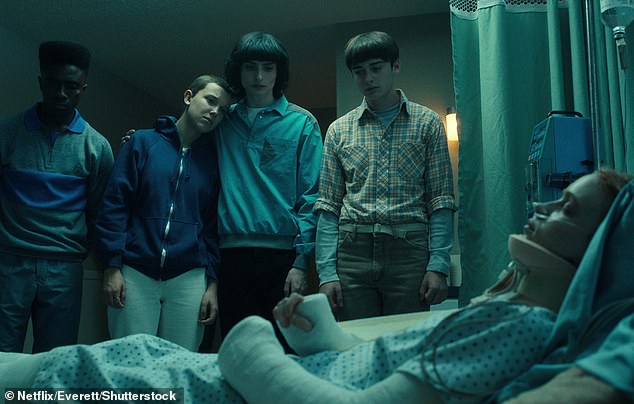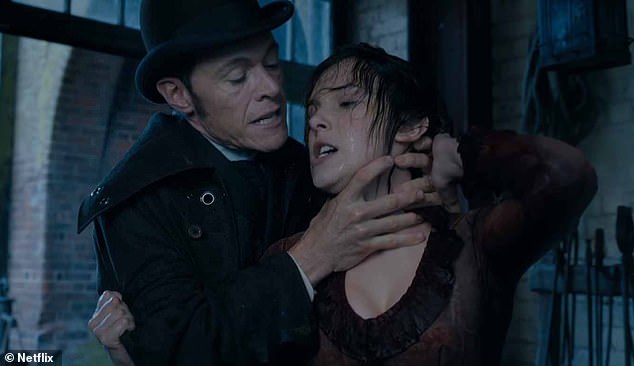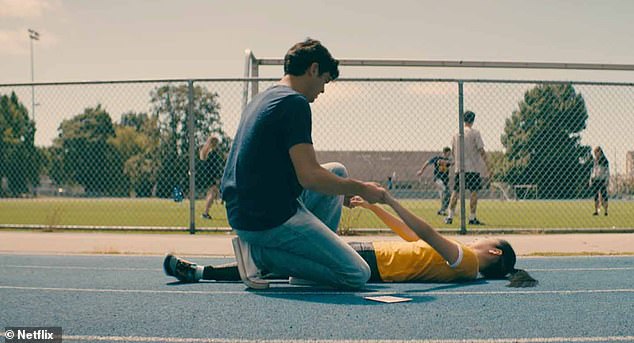Netflix is trivializing the pain that teenagers experience in popular content such as Sex Education, Stranger Things and Spiderman, a new study claims.
By studying more than 60 hours of Netflix movies and TV shows, psychologists found that teen characters’ depictions of pain are “misleading.”
Too often, physical pain on Netflix is presented as something that arises only through a violent act or injury, like being attacked or having an accident, they say.
But the most realistic forms of pain in the real world are “chronic pain,” such as headaches, back pain, menstrual pain, and pain caused by diseases such as cancer.
Since these Netflix productions are primarily aimed at teenagers, experts are now calling on the streaming giant to change the way pain is portrayed to better teach them empathy and compassion.

Netflix trivializes teen pain, says a new study by psychologists at the University of Bath and the University of Calgary. In the photo, a scene of pain in Stranger Things.
The new study was led by researchers from the University of Bath and the University of Calgary in Canada.
“If we don’t show the types of pain that teenagers typically experience, such as back pain and period pain, then we are trivializing pain,” said Dr Abbie Jordan, from the Department of Psychology at the University of Bath.
“We’re not doing a great job of allowing them to think about how to manage pain, how to talk about pain, and how to show empathy when other people are experiencing pain.”
The study, published in the journal Pain, looked only at examples of physical pain, not emotional or psychological pain.
The researchers analyzed how the characters’ experiences of pain were represented in different Netflix content aimed at young people between 12 and 18 years old.
They studied 10 films and six television series, which is equivalent to more than 60 hours of footage.
The films included Spider-Man: Homecoming, Alex Strangelove, Enola Holmes, Midnight Sun and The Perfect Date.
Meanwhile, TV shows analyzed included Sex Education, Stranger Things, Outer Banks, Riverdale and 13 Reasons Why, which controversially depicted topics such as teen suicide, sexual assault and rape.
Of all the productions, Outer Banks, a show that shows teenagers searching for treasure on an island, had the highest number of grief cases: 145.
This was followed by the popular science fiction hit Stranger Things (95), 13 Reasons Why (85) and Riverdale (68), a teen drama about high school students after the death of a classmate.


English actor Tom Holland as Peter Parker/Spider-Man in the 2017 superhero film Spider-Man: Homecoming.


The analysis examined 10 popular films and six television series with teenage protagonists. Pictured is the 2020 Netflix film Enola Holmes
Across the 16 productions, there were a total of 732 painful incidents, an average of 10.24 per hour.
But the majority of these pain cases (57 percent) were violent pain or injuries, rather than chronic or medical pain.
“There was a preponderance of violence and injury, while everyday pain, chronic pain, and medical/procedural pain were rarely represented,” the team said in your paper.
They also found that, in general, pain was quickly dismissed to advance the plot rather than being an important part of the story that requires attention.
Furthermore, there was a general lack of empathetic responses to other characters’ experiences of pain, primarily criticism of the person suffering, but also even humor.
Interestingly, male characters were 77 percent more likely to experience pain compared to female characters.
Boys were often portrayed as heroic figures who came to the rescue and were twice as likely as girls to help the sick, while girls were often portrayed as the “damsel in distress.”
Girls were also portrayed as more emotional than boys in response to witnessing pain.
“If every movie and TV show shows a boy being a ‘tough guy’ when he experiences pain and a girl as a ‘damsel in distress’ who needs to be saved, they might think they have to be like that in real life,” he said. Dr. Jordan.
“This representation reinforces outdated ideas about gender and is misleading.”


To All the Boys I’ve Loved Before: Boys were usually portrayed as heroic and coming to the aid of girls, the ‘damsel in distress’.
The researchers also found that white characters were portrayed as victims of pain more often than characters of other races.
When someone of a racialized identity experienced pain, they were 80 percent more likely to experience pain caused by another person.
“This aligns with stereotypes and distortions about the ability of people from racialized groups to endure physical pain,” the team states.
“There is a belief among some white medical students that black people have thicker skin and therefore have a higher pain tolerance than white people.”
Researchers now want to work with Netflix to address racial and gender imbalances and the lack of realistic depictions of chronic pain.
“We would love to work collaboratively with Netflix and film and television creators to increase the representation of girls and people of color in cases where pain is experienced and start a dialogue about how to more realistically respond to pain in others, thinking in prosocial behaviors and showing empathy,” Dr. Jordan said.
MailOnline has contacted Netflix for comment.
